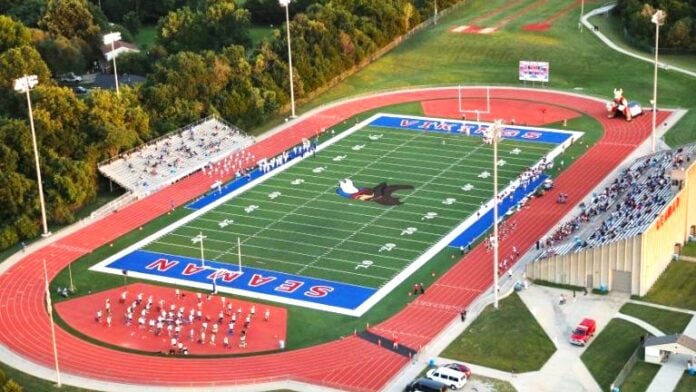Editorial:
By LFK To The 785
In recent news, a Seaman High School student in Topeka, Kansas, recreated a racist promposal sign — nearly identical to a sign made by a student at Olathe South High School in 2021. Whether the Seaman student directly copied the original is unknown, but the resemblance is unmistakable. The recipient of the promposal was a student from Washburn Rural High School.

Brad Willson, superintendent of USD 345 Seaman, denounced the student’s actions in an email to school staff:
“Recently an inexcusable action made outside of school by one of our students hit social media. I will not go into detail or share the content of the social media post because spreading the content only amplifies the negativity and gives it a bigger audience. No racially (or other) inappropriate comments, acts or stereotyping in our schools or at school events should be tolerated in any way. It is our responsibility to ensure that all students have a safe, supportive learning environment. That means both physically and psychologically safe. Please maintain your vigilance to ensure that no students, regardless of race, gender, disability or any other reason, are made to feel less than.”
However, Seaman District has not issued a public statement directly addressing the incident. In contrast, Ed Raines, principal of Washburn Rural High, responded immediately with a public email to parents.
This disparity has not gone unnoticed. Many community members have expressed concern that Seaman’s silence signals a desire to let the controversy “blow over” rather than take visible, accountable action. As This Is Topeka highlighted, one Facebook comment captured the sentiment:
“This is exactly why students don’t feel safe or seen in schools like Seaman. We’ve seen this before. They say the right thing in a memo and hope it blows over.”
And indeed, we have seen this before — particularly in the aftermath of the 2020–21 school year, when Seaman High student journalists revealed that Fred A. Seaman, the district’s namesake, was a high-ranking member of the Ku Klux Klan.
The Seaman Community’s Reaction: Then and Now
When the “Rename Seaman” movement gained momentum following the Klan revelations, students of color and LGBTQIA+ students led a campaign to change the school’s name, operating under the slogan “Same History, Brighter Future.”
They were met with vitriol from community members — especially through a Facebook group called Fight for USD 345 Kids, which remains active today. Students of color were mocked and belittled online, with members referring to them as “brats” and even referencing a “shooting range” in Topeka when discussing the protests.¹
Board member Donna McGinty, aligned with the anti-name change movement, later won a seat on the USD 345 Board of Education.
The district surveyed the community about a name change. The results:
- 45% of respondents wanted to keep the Seaman name
- 16.4% supported changing it
- 34% did not respond, and 4.6% had no preference.
Ultimately, the Board rejected a name change. Instead, they passed a resolution redefining “Seaman” to represent “the community’s long and proud history” — not the man himself. Fred A. Seaman was officially denounced as “racist,” “revolting,” “repulsive,” and “repugnant.” A museum exhibit was proposed to preserve the historical context.
Yet even in this resolution, one could see the flaw: the community was being praised while the founder was isolated as the problem. The systemic issues he helped shape were left unexamined.
What Has Changed?
Not much.
The same indifference that met calls for change in 2020 still persists today. During the Rename Seaman movement, students faced comments like:
“These kids are spoiled. They haven’t paid a mortgage or raised a family. They shouldn’t be allowed to make decisions.”
One commenter declared proudly:
“I’m proud to have graduated from Fred A. Seaman High School.”
The overwhelming message: the discomfort of students of color was less important than preserving tradition — even traditions with roots in white supremacy.
In 2023, the school named its football stadium speaker box after Bob Horton, a former principal and respected community figure.² While honoring individuals is not inherently wrong, it raises questions: if the Seaman community’s identity is supposedly based on inclusion and pride, why do incidents of racial insensitivity — like the recent promposal — continue to happen?
Communities Shape Culture
The Seaman District’s 2021 resolution treated Fred A. Seaman as an isolated bad actor. But it was not Seaman alone who normalized minstrel shows, accepted a Klansman as principal, or shrugged off the rumors of Klan membership. It was the community — a collective, not an individual.
Communities pass on ideas through generations. Racism is not just an individual flaw; it is a learned behavior, reinforced when communities either silently condone or openly dismiss acts of harm as “just jokes” or “childish mistakes.”
The Seaman community — vocal when opposing a name change, silent when students of color were mocked — must reckon with the fact that racism is bred and sustained not just inside schools, but outside them, in homes, churches, and social networks.
Students of Color Deserve More
There is an ongoing argument that these white students should be allowed to “learn from their mistakes” without long-term consequences. While rehabilitation is important, we must first center those harmed.
- Students of color must self-police their behavior daily to avoid microaggressions.
- They attend a school named after a Klansman, despite risking their comfort to speak out.
- They internalize shame about their skin color as early as kindergarten.
- They hear racial slurs in their hallways — a 2021 survey found that 83% of students of color at Seaman reported hearing racial slurs, compared to 70% of white students.
Meanwhile, white students are often afforded grace — their racism dismissed as immaturity rather than recognized as part of a larger, harmful pattern.
Forgiveness is a personal decision for the harmed communities to make — not an obligation. Structural harm demands more than apologies; it demands work. Self-education is no longer optional.
Conclusion: Five Years Later, It’s Still Time to Change
It has been five years since Seaman High’s Klan ties became public. Five years since students rallied for a more inclusive school identity. Five years since the community chose to preserve a name rather than confront its full legacy.
And yet here we are — watching another act of racism brushed off as a joke.
The Seaman community must finally ask itself: Whose comfort matters more — the comfort of tradition, or the safety and dignity of all students?
Because until that answer changes, nothing else will.
¹ Editor’s Note: Statements referencing violence were made by individual commenters on Facebook and are not attributed to official group leadership.
² Editor’s Note: While community sources report the speaker box dedication to Bob Horton, public records confirming the event have not been independently verified.




